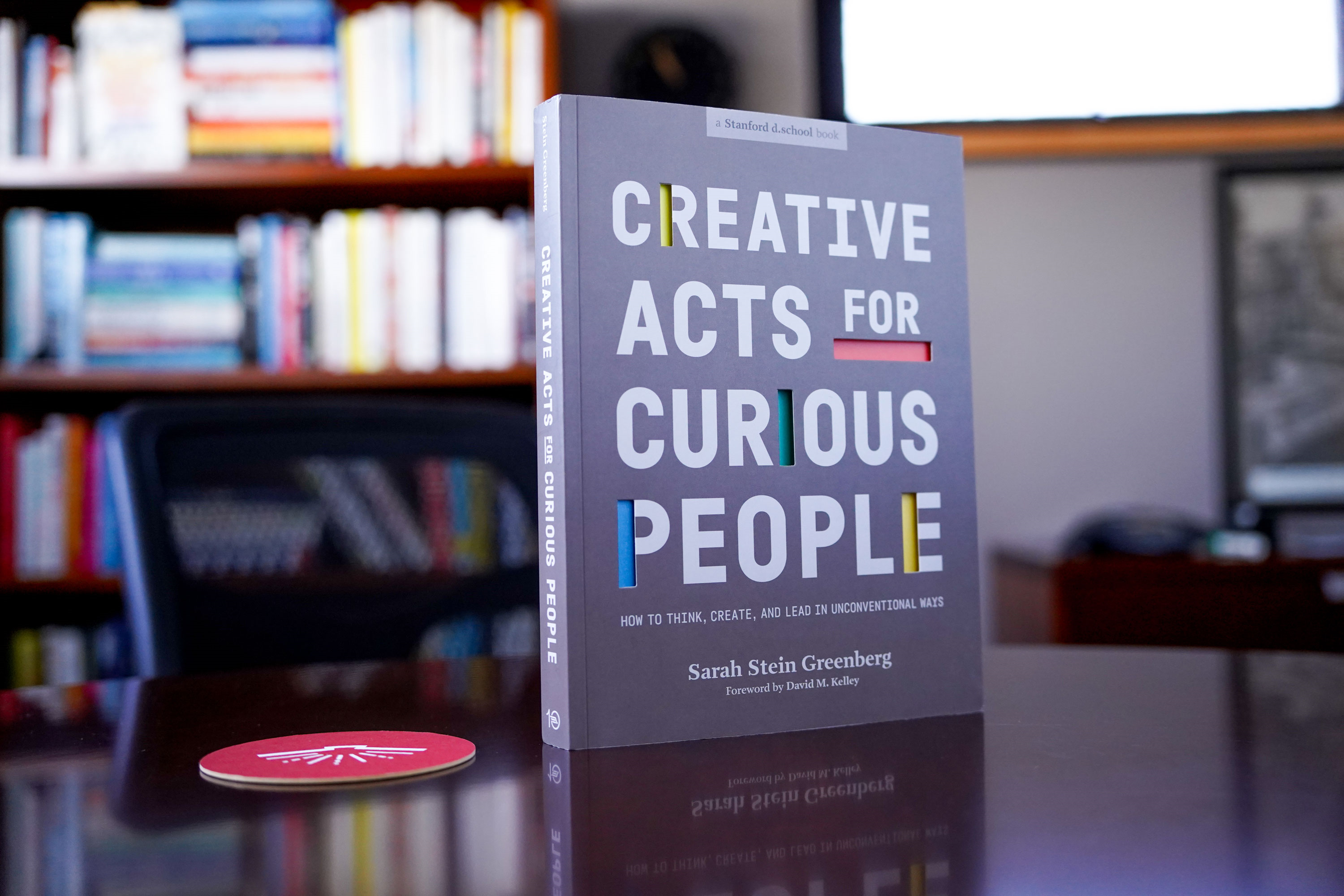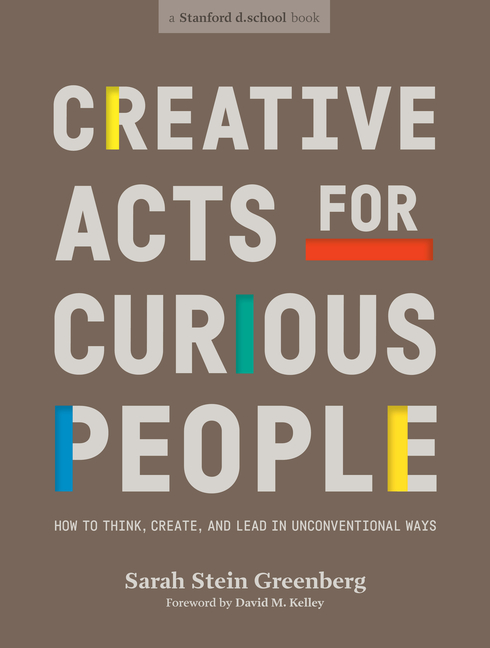Creative Acts for Curious People | An Excerpt from the 2021 Porchlight Innovation & Creativity Book of the Year
January 04, 2022
In the lead up to announcing the Porchlight Business Book of the Year on January 13th, we are going to share excerpts from each of the eight books on the shortlist for the award. Today, we have an excerpt from the Innovation & Creativity book of the year, Creative Acts for Curious People by Sarah Stein Greenberg and the Stanford d.school.
The 2021 Porchlight Innovation & Creativity book of the year is Creative Acts for Curious People: How to Think, Create, and Lead in Unconventional Ways by Sarah Stein Greenberg and the Stanford d.school.
The book is not only actionable, but a hands-on toolkit that provides the reader with activities and creative experience through the over eighty assignments contained within. Chosen by the d.school's executive director Sarah Stein Greenberg from “a wide range of activities developed and taught at the d.school, plus a few that were created elsewhere by members of the extended d.school family,” these “exercises embody playful yet rigorous ideas, and they’ll help you begin to act your way into a new creative reality.”
The assignments may require you to confront some of your fears, or to cultivate a little oddness in your life. They will encourage you to engage with your feelings, to feel the physical world around you, and to engage with and feel the pain and joy of others. As our Creative Director Gabbi Cisneros wrote of the book, it provides “an essential reminder that, although many creatives are introverted individuals, the social aspect of creativity is what brings about the best ideas.”
To explain further, we’ve pulled the following excerpt from Sarah Stein Greenberg’s Introduction.

At the Stanford d.school, we’ve created an environment where normal rules are suspended and we constantly use our imaginations. Our purpose is to help everyone unlock their creative abilities. We cook up special ways for people to interact with each other. We make a lot of time for feelings, and we act like that’s no different than doing any other kind of work. We speak a language of encouragement. We’re hard on work but soft on people, and we don’t confuse kindness with weakness. We try things out before we know exactly what will happen, and then we spend time thinking and talking about what, exactly, just happened. Our furniture rolls around.
Our way of being and working contains a standing invitation to everyone to join us. Almost without exception, we can convince you to come up with a secret handshake at a moment’s notice. We know how to engage a room of adults in a fierce game of Rock Paper Scissors played at top volume. We can give you a bin filled with art supplies and teach you to make something world-changing with them. We can show you how to stop self-censoring your most interesting ideas.
With these methods, we help thousands of people each year expand their creative abilities and apply them to the world. And then those thousands of people help thousands of others do the same. What is this shared, waking daydream? It’s our belief that more creative, meaningful work emerges when we help each other undo the mindsets that limit us and instead hold each other up as creative individuals. At the d.school we make the choice to approach our work this way every day. You can, too.
Although the d.school’s methods are full of joy, I constructed a significant portion of this book during a sad and sobering year. At times the gap between my source material and the world around me felt wide. Our approach to creative work is amplified by collaboration; how does that evolve when people cannot physically come together? Design doesn’t yet have a wide repertoire of tools to acknowledge and fight systemic racism; but if we claim to be human-centered, it must. Since our mission is to democratize access to design, how do we navigate a fracturing, polarized world? When the land is on fire, can nurturing more creative humans bring water?
Design offers methods not for a changed world, but an ever-changing one. In the face of current challenges—those here today and those yet to come—we all need ways to prepare to act even when we are uncertain. We’ll always need to find our way to our reservoir of creative abilities, and figure out how to apply those abilities to each situation.
This book contains a wide range of activities developed and taught at the d.school, plus a few that were created elsewhere by members of the extended d.school family. Many terrific design toolkits and templates are widely available these days; the goal of this guide is to offer you a taste of the kinds of experiential journeys we take at the d.school across a variety of subjects. It gives you the opportunity to experience what it feels like and looks like to learn at the d.school, which you can apply to many different contexts. The skills you will develop are fundamental for stretching your creative abilities: things like becoming aware of your inner critic, bonding quickly with new creative collaborators, and engaging people intentionally to learn more about their lives and spark new ideas.
These experiences, called “assignments,” form the main part of this book. They follow an arc similar to what you’d experience in a course at the d.school, though there are many more here than you could ever fit into one class. Some assignments will take twenty minutes or an hour, and others could take weeks, depending on how deep you want to go. Among the assignments you’ll also find a few essays that share insights we’ve gained by designing these kinds of learning experiences. Knowing more about how they work will help you to get even more out of them and to adapt them to your context.
Throughout the book I refer to the concept of design, a word that means different things to different people. The d.school is part of a global shift: from a world where designers have a very specific, narrow mandate predicated on the idea of design being mainly about aesthetic finishing to a world where design plays a broader role in society. One aspect of this shift in design has to do with inclusiveness: we fundamentally believe that everyone is creative and everyone can use design to improve the world around them. This aspirational way of thinking about design was described by the Hungarian painter László Moholy-Nagy in the 1940s: “Designing is not a profession but an attitude... [it should be] transformed from the notion of a specialist function into a generally valid attitude of resourcefulness and inventiveness.”
[…]
We are fortunate to have carved out this special place where we can set the conditions for creativity to emerge right in the heart of a world-class research university. It’s both a gift and a challenge: our methods build on deep knowledge and the spirit of scientific and technological discovery that pervades Stanford’s campus. We also challenge the norms and orthodoxies of an institution with 125 years of history, 16,000 driven students, and 2,200 staggeringly accomplished faculty.
The d.school’s success is a great argument for welcoming a little oddness into your midst from time to time, a provocation to explore alternative ways of producing new ideas. Our approach to design brings productive, creative tensions: an emphasis on humanness in a time of technological prowess; an embrace of naive, unprejudiced questions in a sector that specializes in expert answers; and a jostling of hierarchy and status to break down barriers across fields and amplify collaboration between unexpected allies.
When we use, teach, and share our ways of learning and working, extraordinary ideas appear. When we practice certain intentional behaviors, they quickly become more natural. As you make your way through these assignments, I hope you also feel the sheer joy that comes from working in this more human, more connected, and, yes, sometimes more childlike way.
Being childlike has helped d.schoolers pursue wide-ranging endeavors. They’ve designed treatments and resources to help children born with clubfoot avert a lifetime of stigma and disability, launched flourishing creative hubs in the heart of countries undergoing political repression, found new ways to unite journalists and technologists, started businesses that created jobs and economic value, and brought humanity and efficiency to the heart of government bureaucracy. They’ve tackled the esoteric (redesigning how lawyers conduct research), the environmental (solar lighting to give more than a hundred million people around the world an affordable alternative to carbon-polluting kerosene lamps), and the economic (storytelling and media services that help locally owned businesses thrive across the United States).
These outcomes are impressive, as are the innovations that propelled them. Even more amazing: the people behind these solutions all started as beginners, with little or no familiarity with design or creative collaboration. By trying and learning these methods, they found truly novel ways to look at an opportunity. That is the d.school’s special contribution: we help open the door to people who have not previously seen themselves as working in a creative field.
But success is never about a single moment of insight. These examples are good ones because the d.school’s founders spent time in an environment that encouraged their natural creative abilities to emerge and because they didn’t stop practicing those learned behaviors after they graduated. They began to believe in and act their way toward a different future.
For some of us this space is physical, and we call it the d.school. But everyone can open a d.school in their own mind.
Reprinted with permission from Creative Acts for Curious People: How to Think, Create, and Lead in Unconventional Ways by Sarah Stein Greenberg and the Stanford d.school, copyright © 2021. Published by Ten Speed Press, an imprint of Penguin Random House. llustrations copyright © 2021 by Michael Hirshon.
ABOUT THE AUTHORS
Sarah Stein Greenberg is the Executive Director of the Stanford d.school. She leads a community of designers, faculty, and other innovative thinkers who help people unlock their creative abilities and apply them to the world. Sarah speaks regularly at universities and global conferences on design, business, and education. She holds an MBA from Stanford’s Graduate School of Business and a BA in history from Oberlin College. Sarah also serves as a trustee for global conservation organization Rare.
The Hasso Plattner Institute of Design, known as the d.school, was founded at Stanford University in 2005. Each year, nearly a thousand students from all disciplines attend classes, workshops, and programs to learn how the thinking and skills behind design can enrich their own work and unlock their creative potential.


